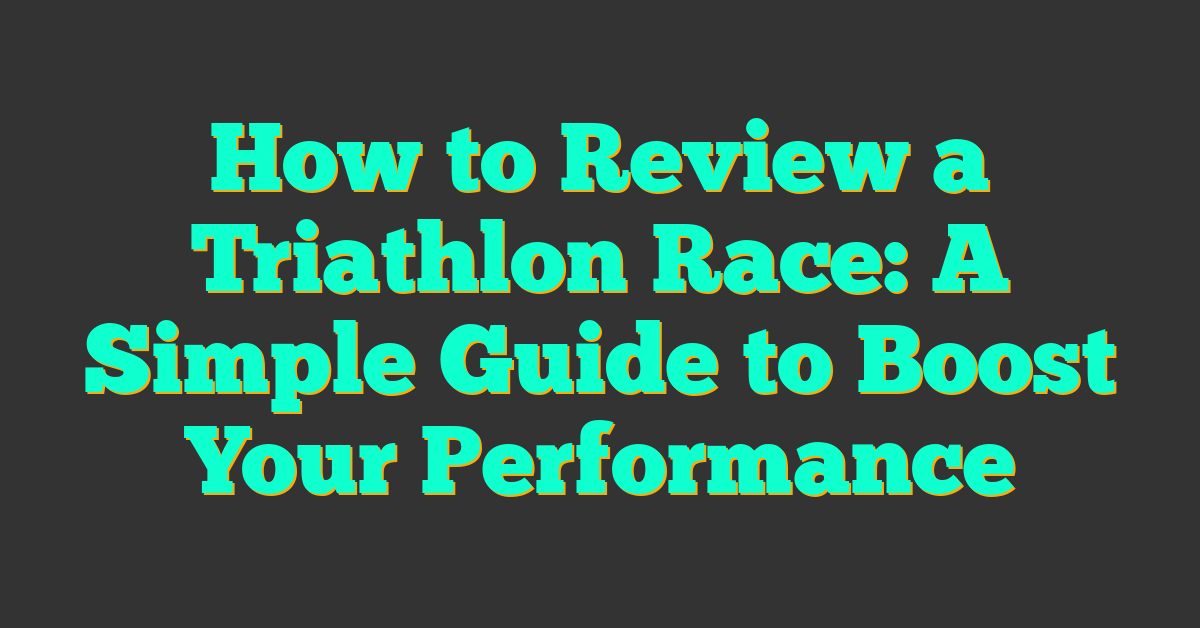Finishing a triathlon is an incredible achievement, but the real growth happens when you take a step back and review your race. I’ve found that reflecting on what went well and what didn’t helps me improve every time I hit the course. It’s not just about the final time but understanding the details that make a difference.

In this article, I’ll share how I break down my race experience to learn from it. Whether you’re a seasoned triathlete or tackling your first event, reviewing your performance can boost your confidence and guide your training. Let’s dive into some simple steps to make your next race even better.
Preparing to Review a Triathlon Race
Reviewing a triathlon race starts long before the post-race analysis. Proper preparation ensures the review is thorough and insightful. My approach focuses on mastering the race format, rules, and gathering key equipment.
Understanding the Race Format and Rules
I begin by studying the specific race format—Sprint, Olympic, Half Ironman, or Ironman—since each requires different strategies and pacing. Knowing the distances and transition layouts influences how I assess performance. I also review the official race rules from the governing body, such as USA Triathlon or ITU, to spot any infractions or penalties that affected results. Understanding drafting laws, equipment regulations, and time cut-offs helps me interpret race data accurately.
Gathering Essential Equipment and Tools
I collect all essential tools to capture race details. This includes GPS watches or bike computers for split times and heart rate data, race maps, and timing chip information. I keep a detailed race journal or digital log to record observations during and after the event. Video footage and photos provide visual context that complements data. I also gather feedback from race officials and fellow competitors when possible, as multiple perspectives reveal insights I might miss alone. These resources make the review precise and practical.
Observing the Race
Watching a triathlon race closely helps me understand key factors that influence performance. I focus on specific moments and details that reveal how athletes handle each discipline and the transitions in between.
Key Moments to Watch During Each Discipline
I pay attention to how athletes start each discipline, especially the swim, since a strong entry sets the tone. During the bike segment, I analyze pacing strategies and how riders handle terrain changes. On the run, I watch for signs of fatigue and any adjustments in form or effort. Spotting these moments highlights what works well and where improvements are possible.
Noting Athlete Performance and Transition Efficiency
I observe athletes’ techniques and energy levels to gauge their overall condition. Transition times are critical; smooth changes between swim-to-bike and bike-to-run can save several minutes. I look for athletes who move confidently through transitions while remaining focused. These observations help me identify areas to fine-tune in training and race day strategies.
Analyzing Race Results
Analyzing race results offers crucial insights for improving future performances. It involves breaking down split times, rankings, and comparing them to past efforts and expectations.
Interpreting Split Times and Overall Rankings
Understanding split times reveals strengths and weaknesses within each discipline. I review swim, bike, and run splits separately, noting where time was gained or lost. Evaluating transition times helps identify opportunities for smoother changeovers. Overall rankings put individual efforts into context against competition and field size, clarifying race standing and progress. Using reliable data from GPS watches and official timing chips ensures accuracy in this analysis.
Comparing Performances to Past Races and Expectations
Comparing current results to past races helps measure progress. I focus on changes in split times, pacing, and recovery during transitions. Comparing efforts to pre-race goals highlights areas that met or missed expectations. This comparison informs adjustments in training plans and race strategies, guiding specific improvements. It also reveals if any external factors like weather or nutrition affected performance differently than anticipated.
Writing the Triathlon Race Review
Writing a triathlon race review helps capture valuable lessons and chart progress. I focus on presenting insights clearly and mixing data with personal reflections for a full picture.
Structuring Your Review for Clarity and Engagement
I organize my reviews into clear sections covering each discipline: swim, bike, and run, plus transitions. I start with a brief summary highlighting overall feelings and key takeaways. Then, I dissect each segment by describing what happened, noting strengths, and pinpointing challenges. Using bullet points for specific details like pacing shifts or nutrition helps keep the review easy to follow. I also add a final summary comparing performance to goals and outlining next steps. This structure keeps the review focused and engaging.
Incorporating Personal Insights and Objective Data
I balance personal insights with objective race data to strengthen my review. Splits, heart rate zones, and power data reveal performance patterns I might miss subjectively. At the same time, reflecting on mental state, conditions, and race-day decisions adds context that numbers alone can’t show. For example, noting where fatigue crept in or where I felt strong helps connect the dots between training and race execution. Combining these angles deepens understanding and guides targeted improvements for future races.
Conclusion
Taking the time to review a triathlon race has become one of my favorite parts of the journey. It’s not just about numbers or times—it’s about understanding what worked, what didn’t, and how I can grow as an athlete.
Each race offers new lessons, and by reflecting thoughtfully, I set myself up for smarter training and better race days ahead. Whether you’re just starting out or have been racing for years, making this a habit can really boost your progress and enjoyment.
I encourage you to make your race reviews personal and honest—they’re a powerful tool for turning every finish line into a fresh starting point.










